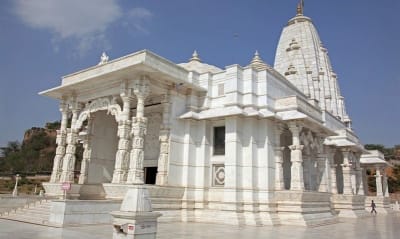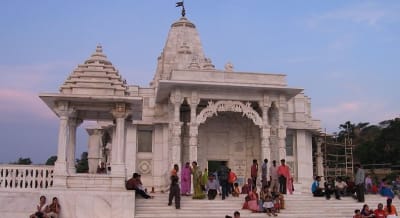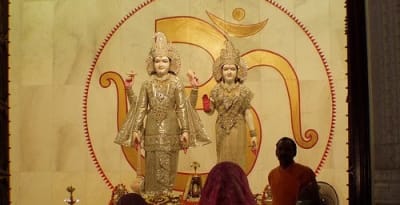Birla mandir jaipur
Birla Mandir Jaipur: A White Jewel in the Pink City
In the busy city of Jaipur, India, there's a peaceful place called the Birla Mandir. It's also known as the Lakshmi Narayan Temple. This stunning temple is made of white marble and is dedicated to Lord Vishnu, who protects the world, and his wife, Goddess Lakshmi, who brings wealth and luck.

About Birla Mandir Jaipur and its Significance
Beyond its stunning aesthetics, Birla Mandir holds immense cultural and spiritual significance. Devotees from all walks of life flock to the temple seeking blessings from Lord Vishnu and Goddess Lakshmi. The tranquil atmosphere within the temple grounds allows visitors to find solace, connect with their inner selves, and experience the rich cultural heritage of India. Here, amidst the intricate carvings and hymns chanted during daily rituals, one can truly find a sense of peace and spiritual renewal.
History of the Temple
The story of Birla Mandir begins in 1976 when the Birla family, a renowned industrialist dynasty, embarked on its construction. Driven by deep-rooted faith and a commitment to social welfare, the Birla family has built several such temples across India. Birla Mandir Jaipur was completed in 1988, and it stands as a testament to their devotion and philanthropic spirit.
Architectural Marvel
Birla Mandir is a captivating example of architectural artistry. Constructed entirely of white Makrana marble, the temple gleams like a pearl against the backdrop of Jaipur's vibrant cityscape. Stepping closer, you'll be mesmerized by the intricate carvings and delicate artwork that adorn the exterior walls. This exquisite craftsmanship blends elements of traditional Hindu temple architecture with modern influences, creating a unique and harmonious visual experience.

Towering over the complex is the shikhar, a distinctive feature of Hindu temples. The main hall boasts beautifully carved pillars, while the sanctum sanctorum (innermost chamber) houses beautiful murtis (idols) of Lord Vishnu and Goddess Lakshmi, carved from a single block of marble. These idols are a sight to behold, radiating an aura of serenity and divine grace.
Significance and Cultural Importance
Birla Mandir Jaipur transcends its architectural beauty. It serves as a vibrant cultural hub, fostering a sense of community and celebrating important Hindu festivals. Here's a glimpse into the cultural significance of this captivating temple:
-
Festivals: Birla Mandir comes alive during major Hindu festivals like Diwali, the festival of lights, and Janmashtami, celebrating the birth of Lord Krishna. During these festivals, the temple is adorned with colorful decorations, and special prayers and ceremonies are held. Witnessing these celebrations offers a window into the rich tapestry of Hindu traditions and customs.
-
Temple Architecture and Symbolism: The intricate carvings and sculptures on the temple walls depict scenes from Hindu mythology, showcasing stories of deities, sages, and mythical creatures. Studying these visuals is a captivating way to learn about Hindu beliefs and their symbolic representation in art and architecture.
-
A Place for All Faiths: An interesting aspect of Birla Mandir is the inclusion of figures representing other religions on the exterior walls. Statues of Buddha, Confucius, Socrates, and Christ stand alongside Hindu deities, reflecting a spirit of tolerance and respect for diverse faiths.
-
Volunteer Opportunities: The temple offers opportunities for visitors to participate in seva (service). Helping with daily tasks like cleaning the temple premises or assisting with offerings allows you to connect with the local community and gain a deeper understanding of temple life.
Planning Your Visit: A Guide to Experiencing Birla Mandir Jaipur
The Birla Mandir welcomes visitors with open arms, offering a chance to experience its spiritual and cultural significance. Here's what you need to know for a smooth and enriching visit:
-
Timings: The temple is open daily from 8:00 AM to 12:00 PM and 4:00 PM to 9:00 PM. This flexible schedule allows visitors to plan their visit around their itinerary.
-
Dress Code: As a sign of respect for the holy site, adhere to a modest dress code. Opt for clothes that cover your shoulders and knees.
-
Free Entry: There's no entry fee to visit the temple, making it an accessible spiritual and cultural experience for all.
Experiencing the Atmosphere of Birla Mandir
A visit to Birla Mandir is more than just sightseeing; it's an immersive journey into the heart of Hindu culture and spirituality. Here are some highlights to look forward to:
- Witness the Aarti Ceremony: Be captivated by the daily aarti ceremony, where offerings of light (diyas) and hymns create a sacred atmosphere. Witness the rhythmic chanting of priests, the gentle swaying of the lamps, and the soft glow illuminating the murtis of Lord Vishnu and Goddess Lakshmi. This ceremony is a powerful way to connect with the divine and experience the beauty of Hindu rituals.-

-
Explore the Temple Complex: The temple complex also houses a museum showcasing artifacts and exhibits related to the Birla family and Hinduism. Here, you can delve deeper into the history and philosophy of Hinduism, gaining a greater appreciation for the significance of Birla Mandir.
-
Panoramic City Views: Ascend to the temple's terrace and be rewarded with breathtaking panoramic views of Jaipur's sprawling cityscape. Imagine capturing this picturesque scene in your mind's eye – the white marble temple contrasting beautifully with the bustling pink city below.
Locating the Birla Mandir Jaipur: A Guide for Travelers
The Birla Mandir is conveniently located in Jaipur's Tilak Nagar neighborhood, near Moti Dungari Hill. Here is the Google maps link of the location of Birla Mandir - Click Here
Here's how you can reach this spiritual haven:
- Within Jaipur: If you're already in Jaipur, reaching Birla Mandir is quite easy. You can take an auto-rickshaw or taxi from your hotel or any other location within the city. The temple is well-known, so finding a driver familiar with the route shouldn't be a problem. Rickshaw fares are generally inexpensive, and negotiating a fair price beforehand is recommended.

-
From Nearby Metros:
-
Delhi: The distance between Delhi and Jaipur is approximately 268 km. You can reach Jaipur by train, bus, or car. Here's a breakdown of the options:
- Train: Trains offer a comfortable and scenic journey from Delhi to Jaipur. Travel time varies depending on the train you choose, but it typically takes between 4 to 6 hours. Upon reaching Jaipur, follow the instructions mentioned above for reaching the temple from within the city.
- Bus: Buses are a more budget-friendly option for traveling from Delhi to Jaipur. However, journey times can be longer, ranging from 6 to 8 hours. Once in Jaipur, follow the instructions for reaching the temple from within the city.
- Car: Renting a car allows for flexibility and the ability to stop at interesting sights along the way. The drive from Delhi to Jaipur takes approximately 5 to 6 hours on good road conditions. Upon reaching Jaipur, you can use GPS navigation or ask locals for directions to Birla Mandir.
-
Mumbai: The distance between Mumbai and Jaipur is approximately 720 km. While flying is the fastest option, you can also reach Jaipur by train. Here's a breakdown:
- Flight: Several airlines operate regular flights between Mumbai and Jaipur. The flight time is approximately 1.5 to 2 hours, making it the quickest way to reach Jaipur. Once in Jaipur, follow the instructions for reaching the temple from within the city.
- Train: Trains offer a more budget-friendly option for traveling from Mumbai to Jaipur. However, journey times are significantly longer, ranging from 15 to 18 hours. Upon reaching Jaipur, follow the instructions for reaching the temple from within the city.
-
Nearby Tourist Attractions
Jaipur, fondly known as the Pink City, boasts a rich history and a plethora of captivating tourist attractions. Here are some must-visit destinations near Birla Mandir Jaipur that will enrich your exploration of the city:
-
Jaigarh Fort: Nestled on the Aravalli Hills, Jaigarh Fort offers breathtaking views of the city and houses the world's largest cannon on wheels. Explore its armory, granaries, and secret passages, and delve into Jaipur's glorious military history.
-
Nahargarh Fort: Perched atop another peak of the Aravalli Hills, Nahargarh Fort boasts stunning panoramic views and moonlit nights. Imagine cooling off in the monsoon winds that sweep through the fort, earning it the name "Nahargarh" (Abode of Tigers).
-
Amer Palace: This majestic fort-palace complex, built in the 16th century, showcases Rajput architecture at its finest. Ride an elephant up to the fort, explore its opulent halls, and marvel at the intricate mirror work within the Sheesh Mahal (Palace of Mirrors).
-
Hawa Mahal: This iconic landmark, with its pink facade and hundreds of small windows, offers a glimpse into the lives of royal women during the Rajput era. Imagine the gentle breeze wafting through these windows, hence the palace's name "Hawa Mahal" (Palace of Winds).
A Memorable Journey Awaits
Birla Mandir Jaipur, with its captivating beauty, cultural significance, and rich history, promises an unforgettable experience. Plan your visit, embrace the vibrant energy of the temple, and embark on a journey of discovery through the heart of Rajasthan.
This blog post provides a comprehensive guide to Birla Mandir Jaipur, covering its history, architecture, cultural importance, significance, nearby tourist attractions, and tips for planning your visit. So, pack your bags, and get ready to be enchanted by the magic of Birla Mandir Jaipur!




